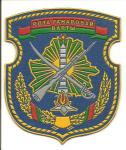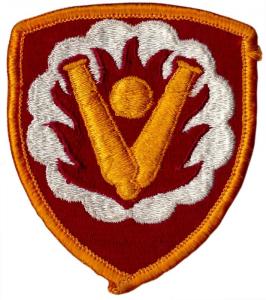Pasaules Militārā Enciklopēdija
> ASV
> Lentes
> Armijas plecu ielāpi
> Artilērijas un tehniskais dienests
> US-PTORUS-00002

59 Ordnance Brigade Patch. US Army
Gadījuma:

Нарукавный знак Роты почетного караула ВС Республики Беларусь

National armed forces Staff Battalion commander Award "Honour sign", 3 class /Latvian National Armed Forces/

Кокарда орешек Вооруженных сил РФ
Mainīt informāciju
Shoulder Sleeve Insignia
Description
On a shield 2 1/2 inches (6.35 cm) in width and 3 inches (7.62 cm) in height overall, crimson with a 1/8 inch (.32 cm) yellow border, a white disc with scalloped rim containing a crimson flame of nine tongues surmounted by a small yellow disc at upper center between two cannon barrels in a V position, their breeches conjoined in base.
Symbolism
Crimson and yellow are the colors used for Ordnance. The cannon barrels represent weapons, the disc at center a round of shot or ammunition, and the flames suggest ordnance repairs. The white area, suggesting a cloud of smoke, alludes to explosives. The position of the cannon barrels simulating the Roman numeral five, together with the nine tongues of the flame, alludes to the organization’s numerical designation.
Background
The shoulder sleeve insignia was approved on 18 April 1980. (TIOH Dwg. No. A-1-655)
Description
On a shield 2 1/2 inches (6.35 cm) in width and 3 inches (7.62 cm) in height overall, crimson with a 1/8 inch (.32 cm) yellow border, a white disc with scalloped rim containing a crimson flame of nine tongues surmounted by a small yellow disc at upper center between two cannon barrels in a V position, their breeches conjoined in base.
Symbolism
Crimson and yellow are the colors used for Ordnance. The cannon barrels represent weapons, the disc at center a round of shot or ammunition, and the flames suggest ordnance repairs. The white area, suggesting a cloud of smoke, alludes to explosives. The position of the cannon barrels simulating the Roman numeral five, together with the nine tongues of the flame, alludes to the organization’s numerical designation.
Background
The shoulder sleeve insignia was approved on 18 April 1980. (TIOH Dwg. No. A-1-655)


